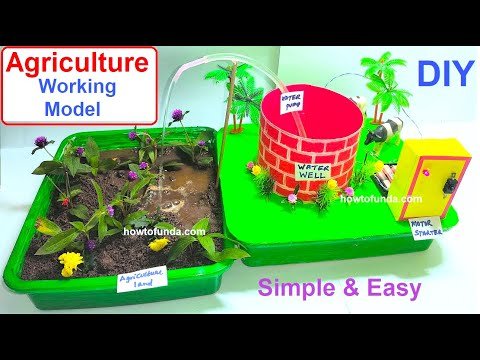An agriculture project working model demonstrates various agricultural processes, such as crop growth, irrigation, and sustainable farming practices.
This model can focus on a particular aspect of agriculture, such as water-efficient irrigation, hydroponics, or sustainable farming methods, to highlight the science and technology used to improve crop production.

Key Components of the Model:
- Soil or Growing Medium: A container or tray filled with soil (or a water-based medium in hydroponics) where crops or plants are grown. This simulates the earth in which plants grow.
- Plants or Seeds: These represent the crops being cultivated, such as small plastic or real plants, or seeds that are ready to grow.
- Watering System: A simple irrigation system (like a drip irrigation or watering can) simulates how water is provided to plants. In hydroponics, this could be a pump system to deliver water mixed with nutrients.
- Light Source: Artificial light (such as a bulb) can be used to simulate sunlight, helping plants photosynthesize and grow.
- Fertilizer or Nutrients: These are added to the soil or water to provide essential nutrients to the plants, promoting healthy growth.
- Sustainable Farming Practices (Optional): Features like composting bins, wind turbines, or solar panels can be incorporated to show environmentally friendly practices in agriculture.
How It Works(agriculture project working model):
- Planting: Seeds are planted in the soil or growing medium. The model could show the early stages of crop growth.
- Irrigation: Water or nutrients are provided through an irrigation system. This can simulate how water is distributed to crops in fields using techniques like drip irrigation or sprinklers.
- Growth and Photosynthesis: The plants receive light, water, and nutrients, and through photosynthesis, they begin to grow. In the model, the plants can be observed to show how they grow over time.
- Harvesting (Optional): If the model is designed to simulate crop harvest, it can show how crops are ready to be harvested once they have matured.
Applications and Learning:
- Real-Life Insight: This model demonstrates the essential aspects of agriculture, including crop cultivation, irrigation, and plant growth, highlighting how technology and sustainability are used in farming.
- Educational Value: It helps explain the science of plant growth, water cycles, and farming techniques, ideal for science fairs or classroom education on agriculture and sustainability.
This agriculture project model offers an interactive way to learn about and demonstrate agricultural processes while showcasing the importance of innovation in farming.

